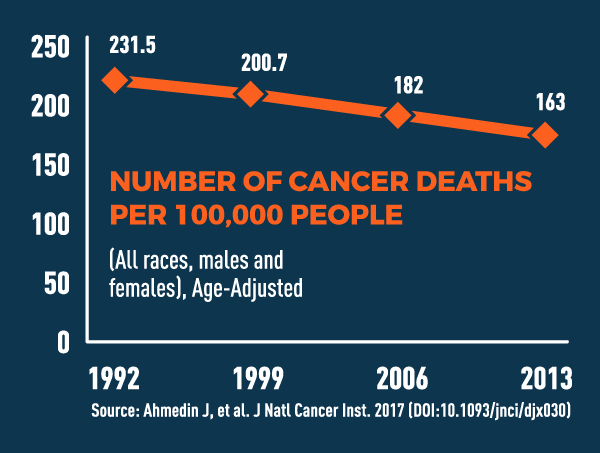Making Greater Progress Against Cancer—Not Just a Hope but a Reality
, by Douglas R. Lowy, M.D.
When one death in four in the United States is due to cancer, progress against this terrible disease is important news. Reading through the recently released Annual Report to the Nation on the Status of Cancer, 1975–2014, I couldn’t help but feel encouraged.
The report—jointly issued by NCI, the Centers for Disease Control and Prevention (CDC), the American Cancer Society, and the North American Association of Central Cancer Registries—finds continued declines in cancer mortality rates for men, women, and children for most cancer sites. I urge all of you to read the report for an excellent perspective on the current trends in incidence, mortality, and survival rates for cancer.
The optimistic portrait of our progress against cancer led me to also reflect upon other ways we can know whether we are making progress.
The CDC’s reported mortality rates (in 2015, the year for which they have the most recent figures) further corroborate a decline in cancer deaths. For the past 5 years, nearly 75% of all deaths in the United States could be attributed to the same 10 causes—led by heart disease, cancer, and lung disease. For eight out of the nine major causes other than cancer, mortality rates increased, and for the ninth, they remained flat. Cancer was the only cause where mortality rates actually decreased (by 1.7%) in 2015.
Having spent my entire career working to better understand the biology of cancer cells and how tumors develop and progress, I see this as very exciting news.
Sustained Investment in Research
To what can we attribute this progress? Cancer prevention is one major reason—and a very important one, because it has the potential to save even more lives in the long run than treatment.
NCI has made significant investments in research over many decades to improve prevention, cancer screening, and early detection, as well as to increase uptake of effective prevention strategies so that fewer people will be diagnosed with cancer and suffer from its physical, financial, social, and psychological harms.
Tobacco control efforts—often founded on NCI-supported research—have certainly paid off in terms of reducing smoking and lung cancer rates over the past few decades. In addition, increased screening for colorectal, cervical, and breast cancer have helped improve mortality rates.
Clearly, NCI’s decades-long investment in basic biological research is another critical component of the continued progress we are seeing. Our deeper understanding of cancer’s complexities has led to new therapeutic approaches that are being applied to a broad spectrum of cancers.
For example, we now incorporate, as part of our treatment arsenal for some cancers, a group of immunotherapy drugs known as immune checkpoint inhibitors. These agents work by “removing the brakes” on the immune system, allowing immune cells to kill cancer cells more effectively.
Very recently, for example, the checkpoint inhibitor avelumab (Bavencio®) became the first ever FDA-approved treatment for Merkel cell carcinoma, a rare and aggressive skin cancer for which there had been no effective treatment until now. It’s worth noting that my colleagues in NCI’s Center for Cancer Research played an important role in the early trials that led to this approval, something of which we can all be proud.
Childhood Cancer
The outlook has greatly improved for young people who develop cancer. Fifty years ago, childhood cancer was virtually incurable. Today, thanks to advances in treatment, the large majority of children diagnosed with cancer can be cured. This has led to a growing population of young cancer survivors, with approximately 100,000 cancer survivors under age 20 in the United States.
Nevertheless, far too many children are still harmed by or die from cancer. Even one child who dies of cancer is one child too many. And although substantial progress has been made against several types of childhood cancer, there are other childhood cancers for which we have made limited progress and survival rates are still low. NCI is committed to speeding progress against childhood cancer and identifying effective treatments to reduce the number of children who succumb to their disease.
NCI, for instance, has been a leader in developing CAR T-cell therapies for children with leukemia and lymphoma. And I’m particularly excited about the expected launch later this year of Pediatric MATCH, the pediatric counterpart to the NCI-MATCH trial of targeted therapies for adults with advanced cancers.
Complexity of Disparities
I was pleased to read in the Annual Report to the Nation that overall cancer death rates decreased for all major racial/ethnic groups over the past decades. However, certain racial/ethnic populations continue to have higher incidence and mortality rates than the general population for some cancers, including liver cancer, kidney cancer, and multiple myeloma.
Survival also varies widely by geographic area, with cancer patients in rural areas, in particular, tending to have poorer outcomes. Although many of these disparities can be attributed to differences in access to cancer screening and quality of cancer care, we need a better understanding of how the complex interplay between genetics and lifestyle influences outcomes.
Our research continues to explore innovative ways to reduce the effects of both biological and nonbiological factors that contribute to cancer disparities. As a society, we must ensure that cancer research and treatment are representative of, and reach broadly across, the entire country, meeting the needs of all demographics—rich and poor, urban and rural, and all racial/ethnic populations.
Survival Rates and Survivorship
Although trends in mortality rates are the most commonly used statistics to assess progress against cancer, trends in survival rates are another key measure. In the last quarter century, the number of cancer survivors in the United States has more than doubled—from 7 million to over 15 million. Two out of three people diagnosed with cancer will survive 5 years or more after diagnosis.
This upward trend in overall survival rates, reinforced by decreasing cancer mortality rates, is a robust measure of progress and very heartening news.
But we must also pay attention to the quality of survivors’ lives. This is nowhere more evident than among survivors of childhood cancer.
Young cancer survivors live much longer, on average, than adult survivors. This means that they will have many more years of dealing with serious long-term and late effects of cancer and its treatment, including an increased risk of second cancers. Our goal is to find more-effective and less-toxic treatments so that, to the extent possible, survivors can look forward to a quality of life after their cancers have been treated that is as good as that of people who haven’t had cancer.
The Long-Term Follow-Up Study, helmed by St. Jude Children’s Research Hospital, is an example of some of the important research that NCI is funding in this area.
Last month, during my visit to St. Jude, the only NCI-Designated Comprehensive Cancer Center that is dedicated solely to pediatric cancer patients, I had an opportunity to hear firsthand a more in-depth perspective on this large-scale, long-term study that is tracking some 24,000 childhood-cancer survivors and their families, and helping us learn more about the long-term health effects of treatment for childhood cancer.
Results from these types of studies have the potential for recommending changes to treatment protocols, such as lower doses of radiation to help survivors live healthier lives.
The Road Ahead
Progress against cancer is big news and inspiring. Yet we know that cancer is still taking too many lives. Moreover, the great strides we are making in prevention, diagnosis, and treatment of cancer is not universal for all forms of the disease; mortality rates for some cancers, such as liver, pancreas, brain, and uterine, are still increasing.
My strong belief is that with our recent scientific discoveries, coupled with our steadfast commitment and galvanized momentum to accelerate progress, we will be able to bring mortality rates down faster and improve the lives of all patients and their loved ones.

